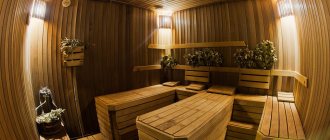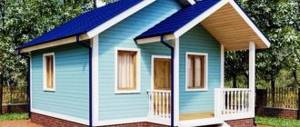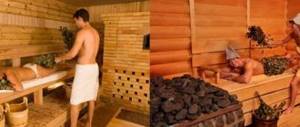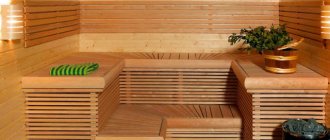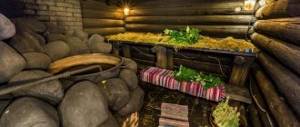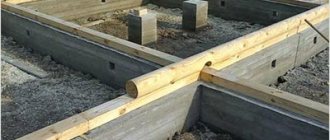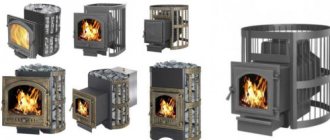Bathing in winter is a separate topic that needs to be discussed separately. We have prepared material that will examine a variety of aspects related to the bathhouse at this time of year: from construction to the behavior of various materials and structures in cold weather, and from the features of operating a bathhouse in winter to how to store birch brooms for a bathhouse in winter.
The benefits of a bath in winter
But perhaps it’s worth starting with a non-construction question: what is the special benefit of a bathhouse in winter? After all, if it’s not there, then what’s the point of lighting the stove? You can wash yourself in the shower, but that’s not why people go to the bathhouse.
Not being doctors, we will simply say that in winter the temperature difference between the steam room and the street is significant, so the contrast for the body and its effect on the blood vessels is also great. But this is provided that you are going to dive into the snow or an ice hole. But are you going? Otherwise, you may not notice the difference between a summer bath and a winter one.
Those who practice rubbing with snow or swimming in an ice hole know that the shaking (especially in the latter case) is very strong. Under the influence of high temperature, the vessels dilated so that the body cooled due to increased blood circulation, and in the cold they sharply narrowed to reduce heat loss.
What is so good about it? First of all - tone. That is, the elasticity of the walls of blood vessels, which determines how well blood flows through the tissues. The appearance of the skin and the condition of the whole body depend on this. Blood brings oxygen and carries away products of metabolism and cell breakdown. Therefore, you promote the nutrition and growth of healthy cells, as well as the cleansing of dead and waste from the body when you improve blood flow.
The heart experiences a shock load during contrast procedures . Those who approach hardening wisely are able to train their heart (it’s a muscle) in such a way that they can significantly reduce the risk of cardiovascular diseases.
ATTENTION! It is reasonable to not heat a bathhouse once a week in the winter at the dacha, but to regularly and consistently engage in hardening, doing it daily at home - starting with dousing with cold water, rubbing with a wet towel, etc. Then the bathhouse will bring maximum benefits.
As for colds, you shouldn’t go to the bathhouse with a full-blown flu. But as a preventative measure, this is a very correct measure. And at the very beginning, if you feel that you have become hypothermic and your nose is already starting to run, the bathhouse will also help not to get sick.
Russian
Shelves in a Russian bath
Actually, everything that was said above can rightfully be applied specifically to the Russian bathhouse in winter. After all, all these snow procedures and diving into ice holes were used by our ancestors. So the Russian bath, with its special temperature and humidity, is very suitable for making a person healthier .
True, if you do everything according to the rules, then for good light steam you will have to spend the whole day worrying about the stove. In order for the stones to heat up to 400 degrees, the stove must be either brick, or in a good casing made of stone or brick. This will not overheat the steam room while the stones are heated in a closed heater. But it will take several hours to kindle it as a matter of course, especially in winter, when the frozen mass still needs to be warmed up.
In general, it turns out to be a bath day. But that's good.
Sauna
With a sauna, everything is somehow simpler and faster - and you don’t need much time to prepare it, and you won’t be able to sit in it for a long time if the temperature is around 90 degrees.
As for Russian fun in the snow and in icy water, they are not at all alien to the Finns. These are also northern people, so among them there are those who like to cool off after entering a steam room in fresh snow or diving into an ice hole.
In principle, the sauna rules themselves say that you need to sit in the steam room for 15 minutes and then cool down. And how to do it - whether to take a cool shower, dive into the pool or go outside and dive into a snowdrift or an ice hole - everyone decides for themselves.
Japanese
Winters in Japan are not warm, but don’t put off washing until summer. That's why the Japanese came up with the idea of heating their barrels of water in which they wash themselves. So even in Russia you can safely use ofuro - this very barrel, which can be located both in a warm room and, if desired, on the street .
This is a man-made “geothermal source”. Since there are many of them in Japan, one must think that they served as the prototype for their bathhouse. Although it’s hard to call it a bathhouse. More like taking a bath.
Photo from Wikipedia
They say that because they were unable to use soap for religious reasons, the Japanese began to wash off oil from their skin using hotter water . In principle, this is true - hot water dries the skin because it washes away fat. And since fat absorbs odors, by washing it off even without soap, the Japanese achieved... well, cleanliness acceptable to their culture.
This means that the water in the ofuro barrel is very hot precisely in order not to use soap. So you can try to sit in a Japanese bathhouse in the winter right on the street - the sensations will certainly be memorable. Let us remind you that the stove is built into this barrel ; it heats the water much like a boiler, only without current. So it's impossible to freeze.
In general, we are inclined to consider this more of an exotic entertainment than a bathhouse. At least in Russia. However, this does not mean that such procedures are useless or harmful. The same warming up of the body, only with the help of water, the same temperature contrast at the exits. Why not?
Regular winter water supply for a bath
Laying a temporary water supply from the air in a bathhouse only under the condition of insulation and constant use of water and a steam room. But even in a pleasant climate, for example, in Sochi, frosts occur in winter, and therefore, sooner or later, this water supply will freeze. For this reason, all air and ground options can only be used in the summer, and for winter dachas the water supply must be laid in the ground.
Laying pipes in dry soil. The first thing that is important to pay attention to before introducing water into the bathhouse is the groundwater level. The most proven and ancient method of laying water pipes for a steam room without unnecessary tricks requires the following conditions to be met:
- The most dense and dry soil, with a low water level on the surface.
- Pipes for bath water supply should be made only of polyethylene, no polypropylene or polyvinyl chloride.
A polyethylene water pipe laid at a depth of 0.5 meters will be very flexible and elastic to withstand water pressure without damage. One sensitive place in the system for a bathhouse will remain the metal fittings - the fittings and taps, by means of which, traditionally, the individual branches of the system are fastened.
Helpful advice! To prevent damage from ice plugs, a section of the water pipeline made of polyethylene, which is laid in a cold room without heating, is joined with couplings and steel bends, and soldered end-to-end, in the form of a single pipeline.
If, after closing the bath, at least 25% of the total volume of water remains in the pipes, then winter-type polyethylene water supply can be connected using all available methods, but the main must be insulated with polystyrene foam.
Exploitation
When frosts begin, the owner of a bathhouse has certain concerns that cannot be avoided if you do not want to encounter unexpected breakdowns and the need for repairs and restoration.
At the moment we are talking about an unheated bathhouse for periodic use. What does it mean? That in the interval between bath procedures the bath cools down to ambient temperature. And if it’s frosty outside, then the temperature inside is sub-zero. This is what happens if the bathhouse is at the dacha, and in winter you are only there once a week maximum.
This specificity imposes certain restrictions even on the choice of stove. Where there is a brick stove, heating takes about four hours, and in general, bringing a bathhouse with a brick stove out of the red requires slowness and care. Iron reaches acceptable temperatures in about an hour - an hour or so.
Therefore, for modern urban people, iron (metal) stoves without thick casings made of brick or stone are becoming more relevant (decorative stone slats do not count).
If you want to take a steam bath in a Russian bathhouse, but without a brick or cast-iron stove with closed heaters, then the only option is to purchase a steam generator that produces the steam that is characteristic of a Russian bathhouse, superheated to a temperature above 100 degrees, which is called “light.”
The iron stove is heated without much precaution, it is flooded in the usual way. no more than two hours to prepare . Upon completion of the bath procedures, you need to ventilate and dry the bath (see below for how to dry a bath in winter).
It is also necessary to drain the water from the water supply system. In this case, you will avoid problems associated with the expansion of water when it turns into a solid state - ice easily tears pipes, toilets, siphons, and in general creates problems that can be easily avoided if you do not give it a chance to form. We also talk about how to do this below.
Living in a bathhouse in winter: is it possible?
A bathhouse is a building in which heating is intended for very specific purposes, namely: to increase the temperature, primarily in the steam room. In addition, this is a building of periodic use, that is, it usually does not provide much of what is needed in a residential building.
In order to live in a bathhouse in winter, it needs to be refurbished to a greater or lesser extent. Since we are talking about the winter period, first of all we need to think about heating.
Using a stove in a steam room every day is not entirely cost-effective. The main heat from it will be in the steam room, the rest have direct heating only if the sides of the stove also face neighboring rooms. Even the firebox brought into the rest room does not provide much heat.
Therefore, it is necessary to either cut the channels and install forced ventilation in them, which will draw hot air from the steam room into adjacent rooms, or install heat exchangers or simply water tanks, but with the goal of using hot water for heating. In this case, installing radiators cannot be avoided.
There is an option! You don’t have to bother with the sauna stove and use an autonomous boiler to heat the water.
Of course, you can get by with a potbelly stove or other heater outside the steam room. But this is more suitable for a temporary place, when you already need to live, but nothing really has been done for this.
Use of a bathhouse with accommodation in winter
But there are also those who immediately build a bathhouse with accommodation. This could be planned as a guest house, for example.
How is this bath different from a regular one? It has additional rooms or dedicated spaces: bedroom, kitchen and toilet. The kitchen, of course, can be an area in the recreation room.
In addition to the amenities in a bathhouse with accommodation in winter, there are always additional heating devices - this can be a boiler, a boiler that heats water for water heating, these can be electric heaters of various modifications - oil, infrared, etc. Stoves or fireplaces for rooms outside the steam room can also be pre-installed.
There are many options, and they can still be combined in some way if desired.
Since the residential bathhouse is constantly heated in cold weather, the water in it is not drained (although the possibility should be provided for in it), but the need for drying is not canceled. Although in this case, drying occurs in any case, even if everything necessary is not done right away - simply due to the constant positive temperature (it’s like in an apartment with a bathroom).
The most common diagrams for connecting pipes in a bathhouse
When arranging a winter water supply system for a bathhouse, it is necessary to take into account the material of the pipe line and the climatic conditions of the region where the personal plot is located. Depending on the type of individual or public source, the methods of supplying water to the sauna room are determined:
- From the centralized water supply of the dacha economy;
- From an autonomous water shaft drilled at a distance of at least 20 m from the sauna house;
- From its own well, located away from the thermal treatment annex.
Creating a winter water supply system for a free-standing bathhouse with your own hands is a little more difficult than water supply for a residential building due to the lack of constant heating of the room. The greatest difficulty is connecting an antifreeze water supply to a centralized network.
How to supply water to a bathhouse from home or a centralized network
Areas with a central water supply allow for water supply according to a simplified scheme. When choosing a place to build a sauna, it is necessary to ensure the minimum length of communications. An efficient boiler installed in the steam room allows you to enjoy water treatments at the optimal water temperature.
Connecting a private bathhouse to a centralized water supply requires a special permit for insertion into the main pipeline. The preparation of documentation is accompanied by a study of the design of an individual water supply system, diagnostics of indicators of the volume of moisture consumed and the predicted performance of the installed equipment.
A prerequisite for gaining access to the centralized network is the installation of electronic devices that control water flow. Meters are subject to mandatory registration with the relevant authorities.
When laying a pipeline connecting the steam room to a residential building or centralized system, it is necessary to adhere to the diagram. The method of installation is provided for by the design, taking into account the geological characteristics of the site and the climatic features of the territory.
In order to independently install a non-freezing water supply from the house to the bathhouse, a novice master will need to lay a certain number of pipes. To correctly determine the length of the pipeline, it should be taken into account that increasing the length of the pipeline increases the pressure in the system. Therefore, when purchasing equipment, it is recommended to choose household appliances that are minimally responsive to changes in pressure.
Connection diagram of pipes to the bathhouse and to the main line
Polyethylene pipes are not destroyed by repeated freezing. Vulnerable areas of the winter water supply structure are considered to be the connection points with the valve and filter device. Metal elements are designed to connect an individual water supply system to a centralized main.
To prevent mechanical damage under the influence of negative temperatures, it is recommended to run the pipeline into the steam room through a special caisson or well. The construction of such a structure to ensure protection of water pipes from freezing is recognized as the optimal option for arranging the winter water supply for a bathhouse with irregular use and lack of constant heating.
After completing the bath procedures, the remaining liquid is removed from the system through a pair of special taps designed for draining. The first is located after the inlet valve. The second is installed at the lower boundary of the water supply in the interior of the steam room.
To ensure the protection of the pipes, the owner needs to go down into the caisson, stop the water supply by shutting off the incoming pipe and unscrew the drain valve. When the drain valve mounted on the section of the pipeline located inside the sauna is closed, the liquid does not leave the system. Therefore, to complete the procedure, the bather will need to return upstairs to the bathhouse and open the required valve.
The result, indicating that the operation was performed correctly, is the normalization of atmospheric pressure in the line. The remaining water in the system flows into a plastic tank installed in the caisson.
Connecting the water supply from the house to the bathhouse
Since summer residents do not use the steam room every day, the room does not require constant heating. With the onset of frost, the likelihood of freezing of the pipeline laid along the street from the residential building to the bath house increases. One of the most common ways to solve the problem is to drain the liquid from the water supply system after the next water procedure.
To achieve the result, it is recommended to use a deep-well pump without a shut-off valve, lowered into a source of autonomous water supply in a suburban area. When the unit is turned on, the container is filled with water. After the pump is turned off, the liquid substance flows through pipes laid through the air with a slight slope in the direction of the steam room.
The simplest option for connecting a bath main is to connect a heated residential building to the water supply system. The recommended material for the pipeline is polypropylene. Experts prefer to use polymer products of the “Stabi” brand. Thick aluminum foil used for pipe reinforcement improves the quality characteristics of the product.
Inside the inhabited building, the water supply is connected to a high-temperature water supply system. It is allowed to connect the pipeline to a cold circuit provided that additional heating of the main line is provided. Polypropylene pipes are heated by placing a special element on the connecting fitting. The spread of heat over a length of up to 7 m is facilitated by the thermal conductivity of aluminum foil.
It is recommended to lay the winter pipeline between the residential building and the steam room underground. A shallow trench up to 70 cm is filled with a layer of sawdust or other bulk insulating material. The polymer pipe is covered with two-layer polypropylene thermal insulation, placed on a cushion and covered with soil.
The distance between the heated building and the bathhouse, exceeding 7 m, creates additional requirements for the insulation of the water supply system. Experts advise using a special heated cable that has the ability to self-regulate. A wire powered by 24 V is applied to a plastic pipe covered with metal foil in spiral turns. Before laying in a trench, a layer of thermal insulation is applied to the polymer product.
Cable insulation of the main line requires a certain energy consumption. To prevent financial costs of paying for energy, thrifty owners install special thermostats for the heating cable or look for alternative ways to protect pipes from freezing.
Arrangement of water supply from well to bathhouse
No less popular among owners of country estates is the supply of water to the bathhouse from a local well. Based on geological origin, well fluid is divided into 2 categories:
- extracted from sandy layers located at shallow depths;
- supplied from deep underground aquifers in limestone.
Maximum purity, ensured by the passage of many layers of ground rocks acting as a natural filter, is characterized by the 2nd variety, alternatively called “artesian water”. The location of the source at a great distance below the surface of the earth contributes to the natural purification of the liquid substance.
If there is a full-fledged sewer system with the removal of waste moisture into a special tank, represented by a septic tank, it is allowed to build a steam room over a well. The construction technology provides for the arrangement of a shallow strip foundation with an insulated support strip and blind areas.
For a shaft located outside the sauna house, it is recommended to equip a protective caisson device made of brick with a double hatch. The use of a 70 mm insulated foam plastic or polystyrene foam flap at the well head helps prevent freezing of shut-off valves. It is allowed to insulate the shaft of a mine with layers of PPS or polyurethane foam, covering the walls of the structure with polymer plates.
To drain the liquid, a drain valve is mounted on the outlet pipe of the deep-well pump, complemented by a special adapter made in the shape of an elbow. The fitting connects the pipeline to the borehole. Opening the drain valve allows any remaining moisture to drain out of the water main.
Some summer residents install high-tech equipment that provides the ability to remotely control the solenoid valve. When using electronics, there is no need to go down into a coffered well after each bath to drain water from the water supply pipes of the steam room. Practical application has proven the effectiveness and increased reliability of manual valves.
Water supply to the bathhouse from a well
Most summer residents supply liquid substance to the steam room from their own well, located at some distance from the bath house. In such cases, a submersible pump is involved in delivering water to the sauna room. The pipeline is laid at a depth of 2 m below the surface, connecting to the well shaft through a hole in the side wall of the shaft. At the same time, a corrugated stainless steel pipe or rubber hose is laid to accommodate the cable connecting the pump to the power supply network.
To prevent the formation of an ice plug in the winter water supply from a well, the design of the pump is slightly changed. The check valve is removed from the unit. An atmospheric drain valve is added to the bath water supply system to discharge water. When the tap is opened, the liquid flows into the well shaft.
With the absence of an air choke, the process of removing moisture from the pipes is delayed. In severe frosts, the likelihood of water runoff icing increases. Therefore, installation of the device is recommended by specialists to prevent defrosting of the water supply line of the steam room.
Separate requirements apply to the insulation of a well shaft. The material used is extruded foam, which is not subject to crumbling. To protect against falling leaves, branches and other debris, a special cover is made to cover the well.
A necessary condition for ensuring effective operation of the bathing water supply system is high-quality sealing of the outlet pipe supplying water from the well pit to the bathhouse extension. It is not advisable to use bitumen mastic due to the increased likelihood of contamination of the liquid.
When arranging a winter water supply for a steam room, it is necessary to take measures to insulate the upper zone of an autonomous well on a personal plot. The pipeline outlet from the shaft must be located below the freezing point of the soil.
The use of heating cables for water supply in a bathhouse in winter
The article repeatedly mentioned the use of cable heating to prevent freezing of pipes in a bathhouse in winter. This is one of the most popular and advanced methods of heating pipes.
In this case, the heating cable is wound in turns around the pipe and covered with thermal insulation. After this, the pipe is either buried or left on the street in this form. Resistive and self-regulating cables are used for heating. The second option is more preferable, because in areas of greatest freezing, the cable heats more intensely, and in those areas where it is already warm, it minimizes the release of thermal energy.
It is also possible to place the heating cable inside the pipe using special gland entries. The only condition will be a sufficient diameter of the pipes to extend the heating wire. In this case, a cable with a special food sheath, but of lower power, heats the pipe just as effectively, but with less electricity consumption.
Barrel sauna
One of the bathhouse options on the site is a barrel bathhouse. This is a fairly compact and mobile structure that is not firmly connected to the foundation (often it is not made at all, limiting itself to supports on the ground). That is, a barrel sauna can be transported if necessary, or even made into a mobile sauna on a trailer. See the article about cedar barrel saunas.
Barrel sauna made of Altai cedar. Photo BanBochka
However, there are many questions regarding how a barrel sauna behaves in winter. Let's consider them sequentially.
Barrel sauna in winter: pros and cons
Of course, every thing has both advantages and disadvantages. But in order to make an informed choice, you need to know both, and weigh which is more significant.
The pros and cons of a barrel sauna in winter stem from its design and purpose. Firstly, the barrel shape was chosen by the Finns, who created it to make the ceiling vaulted - this has a beneficial effect on the distribution of hot air from the stove, which, spreading over the vault, slides down, evenly heating the space.
For winter, this design is definitely a plus, because it provides quick and high-quality heating of the air.
Small dimensions are good not only for mobility, but also for the same warm-up speed: the smaller the steam room, the easier it is to heat it. And since the Finns designed the sauna, the main thing is that a seated person can fit comfortably.
Well, from what was said above, it follows that there cannot be a real Russian bathhouse in a barrel. However, we note that a steam generator could help here too. And so - this is precisely a sauna with a small iron stove, providing a regime that is often called “dry air”.
It is clear that the design and dimensions of the barrel are a plus, but this is a sauna. Cons... Well, many disadvantages come out when the company does something wrong. You need to understand that a wooden barrel on a screed with clamps changes its dimensions, and how it will behave depends the quality of the clamps The owner is required to tighten and release, but it happens that the tree simply breaks the clamps, you need to immediately install it more firmly.
It happens that the ventilation is done crookedly, it happens that the stove is poorly insulated (we are talking about the chimney and the distance to the wood) and creates a fire hazard. There are many different jambs - depending on your luck with the company. Everything needs to be checked and understood why.
A common problem is rotting wood under windows and wherever water accumulates after precipitation. This can be solved either by installing the bathhouse under a canopy (the Finns most often do this) or by canopies covering the ends.
Bath-barrel made of cedar. Photo BanBochka
RESULT: the barrel sauna is structurally good in winter, but it must be made with high quality and needs some protection from moisture inside and outside.
Bathhouse-barrel, insulated
Another important question: does a barrel sauna have to be insulated for winter?
Let's start again with the design. Barrels can be single-layer, consisting only of a frame and insulated, with a “pie”, where there is an outer frame, insulation and inner lining.
At first glance, insulation is mandatory for particularly frosty areas. But it is not so. In reality, a small barrel made of a single-layer frame can easily warm up acceptably only through the stove and keep warm throughout the entire time of the bath procedures.
An oval barrel sauna made of cedar with a capacity for 4 people, the mode supported is a Finnish sauna. Photo BanBochka
Why is that? The principle is the same as for steaming in a mobile sauna made of fabric or film - the main thing is to create an obstacle to hot air , and then maintain its formation. And everything will hold out fine.
IMPORTANT! Everything is valid as long as the stove is working and the stones in the heater are not cold.
But why then do we need insulated options? Oddly enough, the main reason for their appearance is the material from which these barrels are made. If they are used with cheap pine or fir, then the single-layer one will cry with resin. And if you insulate the coniferous wood with the same mineral wool, and line the inside with hardwood - linden or aspen, then you get a bathhouse that is cheap to manufacture and without problems with resin.
Operation of barrels
We have already said above that for stable operation of a barrel sauna in winter, you need to take care of protecting it from the outside - a canopy or canopies, as well as clearing snow and preventing water from accumulating at the bottom of the ends.
It can also help to treat at least problem areas with antiseptics that prevent rotting (only from the outside!).
You also need to take care of drying the inside. Baths that do not have proper ventilation are especially affected. Usually holes are made and plugs are placed on them. It happens that they forget to do it. If there are none, or few, or they are small, then do forced ventilation - place fans in the ducts. You can also arrange burst ventilation - open windows and doors wide.
ADVICE! It is better to drain water from the bathhouse through a pipe to the sewer or septic tank.
If you have water installed in the bathhouse, then after the procedures you need to drain it completely from the system if the air temperature is already or promises to be 0 degrees or lower.
Video description
This video clearly shows the features of the valve drain arrangement:
In areas with frosty winters (from -20 C), it is recommended to install a water drain valve. The diagram is mandatory when supplying water to a bathhouse that does not have constant heating and is used seasonally. The procedure involves a strict sequence of actions:
- A trench is created under the main pipe using a garden auger. In this case, the depth of the trench is set at least 0.5 m below the freezing point.
- A plastic elbow in the shape of the Latin letter U is soldered into the pipe located above the well. A hole is drilled in the lower part of the product and a fitting is inserted.
- The lower part of the well is covered with sand. A hose is placed on the fitting, the end of which is covered with a protective geotextile cover. In this case, the lower part of the hose must have free access to the sand pad.
The creation of such a system will allow excess water to be drained into the ground. When the valve is closed, the remaining water will go into the ground through the drain elbow. Moreover, if the well is located outside and the water freezes, due to the drainage of excess moisture, the pipes will not burst.
Valve water drain Source ytimg.com
Important! When forming a valve drain, the depth of the water layer must be taken into account. If it is at a minimum distance from the surface, the indicated technique is not used. This is due to the high risk of groundwater pollution.
Insulation and pump connection
One of the most reliable ways to make water supply in a bathhouse so that it does not freeze in winter is to insulate the water supply outlet areas. Any thermal insulation material that can prevent heat loss will do. In addition, it is recommended to insulate the pipes directly, especially in regions with cold winters. You can do this using:
- Creating an insulated zone around the pipe. The easiest option is to use sand. It will not only create a barrier to prevent water from freezing in the pipes, but will also reduce the earth pressure on the pipeline.
- Laying the heating cable along the length of the pipeline. It operates from the electrical network, ensuring a uniform supply of heat.
Pumping equipment connection diagram Source septik.guru
Polycarbonate bath
An original way to reduce the cost of building a bathhouse is to use an existing polycarbonate greenhouse or build a new one, with the expectation that there will be a bathhouse in it.
There is no doubt that such a bathhouse will be a good summer option. But what happens to a polycarbonate bathhouse in winter?
We invite you to watch two videos by the same author - in the first he demonstrates his bathhouse in the summer, in the second - in the winter. According to him, it functions perfectly at a temperature of minus 10 degrees, even if the wind is blowing at this time. Well, at least in this frost everything is fine and you can steam. We think that those who experience more severe frosts should contact the author and ask him how things stand in this case.
Summer video on Odnoklassniki
As for the properties of polycarbonate itself, it can withstand temperatures down to minus 40 degrees, but in the cold it becomes brittle. The upper limit for it is 120 degrees Celsius. That is, the chimney must be very well insulated from polycarbonate. In addition, it is worth taking care of the spark arrestor at the end of the chimney pipe.
When is it profitable to build a winter bathhouse from timber?
Let's go, as they say, from the opposite. If a bathhouse made of timber is being built on a summer cottage, which is not possible to visit with the onset of cold weather and snowfalls, it is not advisable to spend money on a winter option. The same can be said about cases when access to a bathhouse is unlimited all year round, but there is often no time, desire, or fuel to use it.
Even if you sometimes want to heat it in winter, but this will not be done often, it is quite possible to get by with a less insulated building.
In other cases, you need to think about building a winter bathhouse from timber. If it is implemented competently, well insulated and properly equipped in terms of communications (especially with regard to heating and plumbing), then its operation will cost much less, and the conditions for accepting bath procedures will rise to a comfortable level.
Mobile sauna
There are several types of baths. Stationary ones stand on a foundation and do not involve any movement. Mobile ones are simply movable, that is, they are not tied to any foundation and can be transported from one site to another, for example, when moving. If such a bathhouse is loaded onto a trailer and taken out into the countryside, then it automatically becomes a camping one.
But of camp baths. This can be not only a barrel sauna, but also a tent equipped with a stove inside, as well as a frame sauna made of plastic film. The latter may have a collapsible frame or trees will be used instead of a frame.
Tent baths are also varied, but the diversity there is more in the degree of comfort and price. They also differ in the number of people they can accommodate. There are some that can accommodate 8 people and still have room left.
Sogra-3 is installed in a mobile bathhouse. Mobib Photos
In winter, mobile saunas behave excellently, retain heat perfectly inside (we have already clarified that there is either a working stove inside or stones heated by it), you can warm up in them quite quickly, spending about 1-2 hours at the initial stage. But these numbers are not stable; a lot depends on what you warm yourself with - a real stove or a fire with stones.
Travel made of film
The cheapest option for setting up a bathhouse in nature, which also does not require much space in the car, is to fence off the space between several trees with plastic film.
The plastic film should be stretch, but you are free to choose whether it will be cling film or non-food film. The second one is, of course, stronger.
- Everything is done quite simply: choose a place as level as possible, where several trees grow in the “corners” of the future bathhouse.
- Inside this space, choose a place for the fire and lay out the hearth. It is good to use brought bricks. A lattice or something else is installed on the bricks, where stones can be placed.
- Light a fire to heat the stones. In the meantime, while they are warming up, begin to cover the perimeter with film. You will also need a roll of tape.
- Having wrapped the perimeter to the required height, strengthen the bottom, make a door, first strengthening its outline with tape.
- When the fire warms up the stones well and goes out, make a roof from the same film.
The whole process can be clearly seen in this video:
And for those who would like to see how a camp film bathhouse behaves in winter, we recommend this video:
If you are interested in stoves for mobile and camping saunas, check out this article: Review of stoves for camping saunas.
Installation of water supply in a bathhouse
Pipeline installation consists of a number of fundamental stages:
- Design. Initially, the user will have to make accurate calculations, calculate how many meters of pipes will be required, what additional equipment and fasteners will be used.
- Construction of the trench. The trench should be dug below the freezing point to prevent possible icing of the pipes during frosts. If the ground is rocky or clayey, it is recommended to fill the bottom of the trench with a cushion of sand.
Construction of a trench for a pipeline Source yandex.net
- Using special equipment, a hole is formed through which the water supply will be brought out. It is important here to reduce possible heat loss, therefore thermal insulation is laid between the pipe and the ground surface.
- Since most foundations are strip, the pipeline should be placed under the foundation of the bathhouse.
- A separate hole is dug in the ground to accommodate pumping equipment. To ensure uninterrupted operation of the unit, the niche should be insulated as much as possible.
- At the final stage, the pipeline is installed and pumping equipment is connected.
Design
Before laying pipes, it is necessary to carry out calculation procedures and decide on the connection diagram. In order to save time and money you will:
- calculate the amount of thermal insulation material;
- determine the length of pipes required for installation of the system;
- calculate the number and format of fasteners, connectors and fittings;
- determine the additional equipment required for connection.
Design is also necessary in order to obtain consent to carry out work from regulatory authorities.
Does a frame bath keep warm?
Frame baths are one of the options for budget construction. Residential buildings are also built using the same technology. Moreover, they began to be built somewhere in the 70s in Canada. And there it’s cold like in Siberia. So you don’t have to worry about the structure itself; it copes well with thermal insulation.
But what exactly did those who asked whether a frame bathhouse keep warm in winter mean? After all, everything depends on the energy source - if the stove is working, if there are stones or brickwork heated by it, then it goes without saying that it will be warm inside. But as soon as the heat transfer stops, the temperature slowly but surely begins to decrease. And this applies not only to the frame, but also to any other material - log houses or brick buildings cool in the same way.
In essence, if there is a heat source inside, the only thing that matters is the tightness - as long as there is no draft, the heat will stay in even inside the enclosed perimeter of cling film!
But different materials transfer heat to the environment at different rates. Since inside the frame there is a layer of insulation - a material with low thermal conductivity, there is nothing to worry about. In addition, many additionally add a layer of foil in the steam room - it is both a vapor barrier and a heat reflector (if there is an air gap after it).
So a well-heated steam room in a frame bath (and even with a layer of foil) will keep the heat well even on a frosty day. Read about frame baths here.
Sex in a bathhouse is not for the weak
Making love in a steam room is an exciting activity, but not for everyone. With the above diseases, such sex may be the last in life for a mischievous couple (or company), so you should think several times - am I capable of this? If instead of hearts you and your companion have flaming engines, sex in a bathhouse will be a very interesting experience, but you need to remember that the human body and its parts can heat up to hellish heat. There will be no burns, but the pleasure is specific, especially if you constantly run out to the dressing room for a breath of fresh air - you can catch a cold!
Of course, the most important thing is not to land a lady’s ass on the stove in the heat of passion or sit on her yourself. At one time, the hussars got the hang of avoiding this by inventing one game. They covered the stove with boards, soaped the floor in the steam room and placed a naked woman with all her limbs in four basins (there was an option with two - for the elbows and knees). After this, several hussars had their hands tied behind their backs and sent into the bathhouse - the surest strategy was to push the lady into a corner and indulge in fun there. Today, few people will appreciate the eroticism of this fun, but there is definitely something daring in it.
How to store brooms
By winter, the brooms prepared in the summer have already lost moisture and become dry and brittle. Before the onset of frost, they had to be stored in a dark, dry, ventilated room, such as a barn.
Does anything change with the onset of winter? Nothing. By the time frosts arrive, there will be very little moisture left in the brooms, so there is no need to be afraid of them freezing. The moisture that tears the cells apart when frozen is no longer there.
You can safely continue to store bathhouse brooms in the winter in the room that was previously allocated for them.
Let us remind you that you should not choose it under a modern roof if you yourself feel sick from the heat under it on a summer day. It's good to hang brooms in the barn. The garage is not suitable, because we don’t want organic chemicals, which are full of them in the garage, to be absorbed by a broom?
Another optimal hanging storage option is a dressing room or other dry bath room.
In a house where approximately the same temperature is maintained, without changes, as well as stable humidity, it is enough to choose a dark place. This could be a closet, or it could just be cardboard boxes with holes for ventilation, folded where it is convenient for you.
How to store birch brooms
In principle, it is quite difficult to say anything new (compared to what was said above) about how to store birch brooms for a bath in winter. We understand that we are talking about mass storage, not about one or two brooms, so just for information, let’s say that a quick freezer is also an option for storing birch brooms (and all others too).
When quickly frozen, ice crystals do not form and tear the cells, so the brooms are preserved in their original form. However, at home there is unlikely to be an empty large chamber that you wouldn’t mind giving under brooms. But cellars and basements, which are just asking for storage for brooms - they are usually more humid there than necessary.
Alternatively, you can wrap the brooms in dry straw or paper - this will help to preserve them better.
Nuances of thermal insulation of a well
If the well is built using traditional technology and has a log frame, the water in it does not freeze even in the most severe frosts, since wood is an excellent natural heat insulator.
But concrete rings, which are being used more and more widely, conduct heat well, transferring cold from the frozen ground. Wells with a high water table are at particular risk of freezing.
To insulate a concrete well, you will have to dig out rings to the freezing depth for a given region (plus a small reserve in case of a particularly cold winter). Next, the rings are covered with narrow strips of penoplex so as to ensure maximum adherence to the concrete. The gaps between the sheets and rings and the joints are filled with polyurethane foam. Polystyrene foam is not suitable for this purpose; it will crumble when filled with soil. Mineral wool will inevitably become saturated with moisture and lose its heat-shielding properties.
The house above the well should also be insulated with polystyrene foam; this material is not afraid of moisture.
How much firewood do you need for the winter?
In fact, calculating how much firewood is needed for a bathhouse in the winter depends on a couple of individual parameters, so it’s easier to describe the algorithm, and then do the math for your own case.
So, prepare according to how many times you plan to heat the bathhouse during the winter. If every week, then that’s 4 times a month.
Everyone's stove is different, so it would be good to know how much wood usually goes into heating the stove and maintaining the temperature.
IMPORTANT! In winter, the amount of firewood can be approximately doubled compared to summer heating.
This is what you start from - the approximate amount that goes away in the summer at a time, multiplied by two, and then multiplied again by the number of fires per season. Add another 10-15% to this amount and you will have a supply for the winter.
If you don’t know how often you will heat, take the maximum possible number.
Defrosting accessible pipe sections
You can deal with ice jams on open sections of communications, usually located in a building, using the following means:
- Hairdryer, construction or household, vacuum cleaner with the ability to connect a hose to the outlet, fan heater. Using the device, a stream of warm air first warms up the area near the tap, then it is necessary to gradually move along the entire pipe. When handling plastic communications, care must be taken to prevent them from melting.
- Boiling water, which, in the absence of electricity, is heated over a fire. The supposedly frozen section of pipe is wrapped in any rags, rags, old towels, then watered with a thin stream of hot water to keep the fabric moist and warm. The procedure continues until the ice completely melts.
- Electric heating consists of wrapping the communication with a heating wire connected to the network. The duration of defrosting depends on the length of the ice plug and can last up to 3 hours.
Advice! A serious mash can only be heated using a blowtorch in a thick-walled metal pipe. But to prevent damage to communications, this method must be used extremely carefully.
How to make a sauna in winter
“Make” is a flexible concept. This may include construction and specific measures to maintain the bathhouse in the winter. The main thing, in our opinion (besides heating), will be the question of the correct design and maintenance of the water supply system. We recommend reading a large article on this topic, which discusses all the options for supplying water to the bathhouse and how to protect communications from freezing and pipe ruptures.
Organization of winter water supply
Organizing a winter water supply for a bathhouse complex will require solving a number of issues:
- choice of water supply scheme: with drainage of water after each use or a heated room.
- choice of heating source: central or local;
- choosing a water source: water supply, borehole or well;
- selection of pipe material;
Before making a choice, you should carefully calculate how much a particular solution will cost when implemented. This will include the cost of materials, equipment and labor.
Separately, you need to calculate the amount of operating costs over the planned life of the system. This amount includes:
- heating costs (gas, electricity, solid or liquid fuel);
- cost of preventive maintenance (periodic cleaning of the well, blowing out the well, maintenance of heating equipment, etc.)
- cost of spare parts, repairs and consumables if required).
The sum of these three types of costs will represent the total cost of ownership of a particular system. For example, an insufficiently insulated pipe will require large amounts of electricity to constantly heat it. And the use of metal-plastic pipes will require their replacement every few years due to corrosion of metal parts and chipping of rubber gaskets.
Construction in winter
There is a difference when to build. If you are going to make a strip or slab foundation, it is better to do it in the warm season.
There are also restrictions on building a bathhouse in winter from certain materials; in particular, it is not recommended to build at this time of year from block material - brick or foam concrete blocks.
The reason is that it is inconvenient to lay cement mortar in the cold, and the consequences will be sad: the water will harden already at zero degrees, and in winter it will stay lower for a long time. If the cement hardens with ice inside, then the ice will melt and voids will remain. The masonry will collapse. In addition, a seam made in the cold does not adhere well to the blocks.
But there are solutions! Builders solve the problem this way: they either add additives to the solution that lower the freezing point of water, or heat the solution, or heat it up, or insert electrodes into the seams, which, when connected to the network, release heat, heating the seams.
Log house
Another wall material is round timber or timber . Log houses are erected at any time of the year, but a log bathhouse built in winter from a winter forest is literally overgrown with legends.
The first legend says that in winter the flow of sap stops and therefore (!) there is less water in tree trunks. Well, that's a half-truth. Sap flow actually stops or slows down greatly. But where do the juices go? Are they really evaporating? No, they remain in the trunk until spring. Winter trunks are heavier than summer ones - precisely due to moisture.
The second legend tells that our ancestors cut down forests in winter precisely because they were more suitable for construction than summer ones. A fact is a fact, but for the peasant it was also of great importance how to remove the wood from the forest - after all, it would be easier to drag a log through the snow than through a summer clearing. And there is less gardening and field work in winter.
ADVICE! Do you want more or less dried logs? Take a moisture measuring device with you and start visiting companies that sell logs. Don't listen to stories about the preparation time, believe only your eyes.
Moisture meter
If it’s cold in the dressing room, it’s better to lie down in the steam room
Noble bathhouse attendants do not recommend standing in the steam room, and this is not only because those standing shake their genitals at the eye level of those sitting. It's all about the difference in air temperature in the area of the head and in the legs - in the cold season it can be 40-45 degrees.
Because of this difference, problems with blood circulation begin and the risk of a heart attack increases, so doctors recommend lying or sitting on a bunk. The horizontal position allows you to avoid sudden changes in temperature, but you still shouldn’t “stay too long” to avoid overheating. In the dressing room, it is best to wear warm felt boots - your feet should always be warm.
Arrangement of water supply from well to bathhouse
For winter water supply, the bathhouses are insulated. A caisson is constructed from brick or other materials. It needs a solid concrete base with waterproofing. The walls are also coated with bitumen or covered on the outside with roofing felt. Such measures will protect the structure from flooding. The depth of the caisson is located below the freezing soil, and the width should provide space so that a person can freely fit there to service the well.
The building is insulated. Since it is located in the ground, frost protection is only needed from above. Install a double hatch with insulation. If local climatic conditions are harsh, insulating the walls on the outside will not hurt.
A drain valve is installed on the supply pipe. A short elbow goes from it into the shaft. To drain moisture from the bath, open the valve for 10 minutes and then close it.
Connecting the water supply from the house to the bathhouse
If the sauna is no further than 7 m from the heated building, the water supply can be installed without any particular difficulties. Polypropylene pipes are used for hot water. They are reinforced with foil, which retains heat well. Connected to a boiler, geyser or other hot water supply device in the house. Water at this distance cools slightly.
Connection to centralized water supply.
Can be connected to an internal home cold water system. In this case, a special electric cable for heating is mounted on the couplings. The pipeline is laid on a sand cushion in a trench. The main line is additionally protected from frost with polypropylene thermal insulation, covered with expanded clay, and covered with earth.
When the distance to the steam room is more than 7 m, heating is provided. A self-regulating electrical cable is used, which is wound over the foil. Put on a heat-insulating stocking and place it in a trench. For safe operation of the heating cable, a circuit breaker is included in the circuit.

